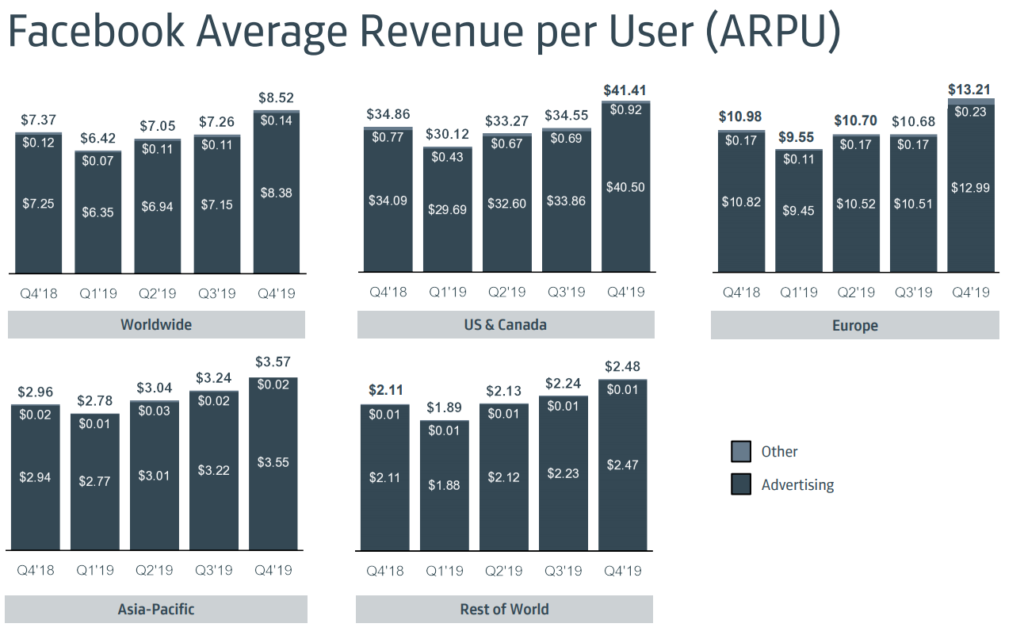This write-up will be broken down into two parts. In this first part, we will discuss Facebook’s business model and metrics for measuring its success.
Facebook probably has one of the best business models in the world. Even before it went public, the company grew its revenue by 57% and had 36% operating margins. Its business model is similar to a traditional media company, with advertising revenue as the key driver. Facebook has the largest readership base in the world (2.5 billion people) and to top it off, the readers are the ones providing the content for free.
What does Facebook Own?
Facebook properties consist of five products. Most of us are familiar with them and would use four out of five products on its properties – Facebook, Instagram, Messenger and Whatsapp.

Among all the properties Facebook owns, the company’s two main revenue drivers are Instagram (acquired at a bargain price of $1 billion) and Facebook. Facebook’s priority is to continuously invest in these social media platforms.
Messenger and WhatsApp (acquired for $16 billion) are mainly for messaging and are more difficult to monetize, especially for WhatsApp when Facebook is trying to brand it as less intrusive with its encryption capabilities. However, it does make the platform ‘stickier’. The more functions your users rely on your platform for, the more engagement you will receive, and revenue will follow. Facebook currently has plans to integrate Messenger, WhatsApp and Instagram to increase its platform’s ‘stickiness’.
Oculus was acquired back in 2014 for $2 billion because Zuckerberg believes that Virtual Reality (VR) would be the next major computing platform. Though its success has yet to bear fruits in terms of widespread adoption, Zuckerberg believes that VR could be the next big revolution. It is comforting to know that the management is on its toes preparing for the next big wave. This parallels their massive pivot in strategy during 2011 as users shifted their preferences from surfing Facebook on desktop to smartphone devices browsing.
Network Effect – Exactly How Many People Are on Facebook?
Across the globe, Facebook splits its business into four geographies:
- Rest of World
- Asia-Pacific
- Europe
- US & Canada

With a rising MAU, the company now has approximately 2.5 billion active users on its platform. To put Facebook’s incredible reach in perspective, the world’s population is 7.8 billion, of which 4.6 billion have access to the internet. Due to censorship, let’s remove China’s population of 1.4 billion from the 4.6 billion pool of internet users. That would leave us with 3.2 billion people who could be users of Facebook.
This means that Facebook has captured 78% market share of its total possible users. Think about the amount of data they could collect on its users based on sign up details, photos, likes, friends, and when you log in to other platforms using your Facebook account (e.g. Spotify). It is no wonder their targeted advertisements generate much better returns for their advertisers.

And about 66% of its users check their app at least once a day.
Facebook properties have huge network effects, and the great thing about networks is that as the user numbers grow, their moat widens exponentially as it grows. The size of the platform acts like a magnet for both users and businesses to join. It is able to retain users because that is where all our friends are and likewise, it is difficult for businesses to leave because that is where all its customers are.
How Valuable Are You to Facebook?
Out of the 2.5 billion users, only 10% are from US and Canada, yet they generate close to 50% of Facebook’s revenue.

From here, we can see that US & Canada’s ARPU is at least 4x the worldwide average.
This leaves a lot of potential for revenue growth from its market outside of the US & Canada. The reasons Facebook gets a higher revenue from US & Canada are largely due to:
- Price increases, this is likely attributed to the purchasing power of consumers. The recent article by WSJ suggested that ad rates may have fallen by 25% in Mar 2020 due to COVID-19 induced economic downturn, even though usage has increased by 50%.
- The number of ads shown, mature markets tend to have a higher ad load.
- Higher engagement, US & Canada users are more likely to share, like and comment. We can expect to see this increase as Facebook rolls out more features such as Live Stream, Watch Party, etc.
- More ads clicked, with more targeted ads leads to more clicks and higher cost per click.
Interestingly, we can see that we as Singapore (Asia-Pacific) users “brought in” at least USD12.63 worth of revenue (ARPU) for the platform in 2019 and this figure is expected to grow over time.
In my next article, I will further discuss Facebook’s profitability, growth potential and the challenges it faces, including regulatory concerns surrounding the Cambridge Analytica incident. Stay tuned for Part two!

